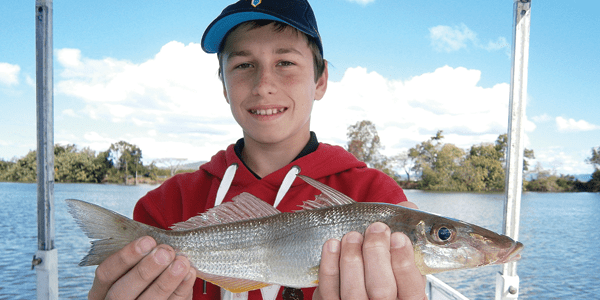WITH the air and water temperatures rapidly rising as we move into the summer months, now is a very apt time to discuss targeting whiting on lures. The interesting thing about this topic is if you turned back the clock to not that long ago the thought of catching whiting on lures was looked upon as almost eccentric madness.
But of course it is now widely accepted that whiting will take a variety of lures retrieved with a variety of techniques. Whiting, unlike some species, are multiple spawners and the larger specimens will be carrying either milt or roe depending on whether they are male or female, and they will spawn on the week leading up to both the full and new moons all through summer.
This breeding bonanza means the fish will be schooling and hungry as well as territorially aggressive. The warm summer water temperatures also mean whiting’s metabolisms will be running rampant. It’s a combination of all these factors that makes this species such a viable lure fishing target.
Before we start talking about the lures, let’s begin with some of the best times and locations in which to find these tough little battlers.
As mentioned above, the lead-up to both the full and new moons sees a spike in whiting activity, and provided we don’t receive a massive amount of rainfall, the mid to upper reaches of the estuaries will be the place to find them. I don’t factor in fishing the tides too much because whiting seem to bite freely on both the run-in and run-out tides.
The main feature I look for is dirty water. Mass discoloration in the water makes this species feel comfortable to school and feed as well as spawn.
Discoloration can be found and created by numerous factors such as the bottom or the banks of a river being a bit muddy. Strong tidal flows and wind can also become agents in dirtying the water, or as I call it stirring the pot.
It is a fact that for some reason the northeasterly wind that becomes very common through summer helps to stir the pot in our local rivers. When the northeaster blows, whiting of all sizes move right up into the shallow dirty water along the river edges and in contrast move back into deeper water during a constant run of southerly wind.
The occasions when whiting are right up in the shallows present the best time to put into practice our first technique: targeting them on surface lures. Whiting will respond to all types of surface lures whether they be small poppers, stickbaits or pencils. Years ago when I first started experimenting with surface lures for whiting I thought a slow popping action across the top might be the way to go, but as time has passed I have found a long cast and medium-paced to quick continuous retrieve with the rod tip held low to the water to be the most effective.
I am sometimes amazed at how hard these fish strike a rapidly retrieved surface lure and the lure I have the most success with is the Bassday Sugapen. Trolling small hard-bodied minnows that are no longer than 55mm through the dirty shallow water is another successful technique as long as your lures are continuously skimming and tapping the bottom.
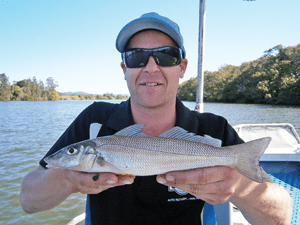
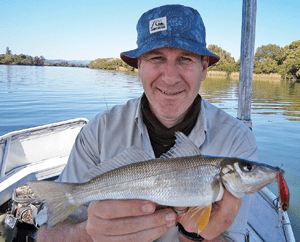
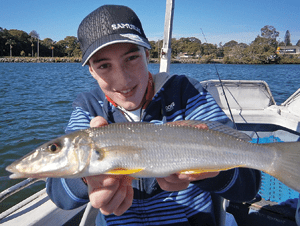
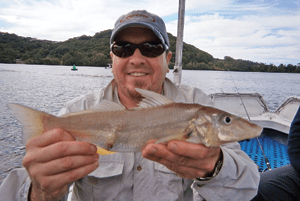
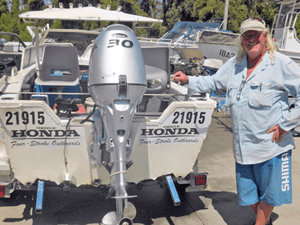
Small hard-bodied minnow lures can of course be cast and retrieved through the shallows with the same principle as trolling (ensuring the lures are continuously hitting the dance floor). When whiting are in deep water I turn to only one style of lure and that is small metal blades up to 40mm in length.
Blades are very versatile when it comes to fishing deeper water because they are quite heavy and sink fast for such a small product. They have two sets of small trebles placed close together which increases the whiting hook-up rate due to their very small mouths. Blades can be jigged vertically or cast and retrieved in deep water and I always use the same technique of hopping the blade across the bottom at 30cm intervals. To ensure the lure hops at 30cm intervals, flick your rod tip with 30cm movements.
Small, well-weighted soft plastics hopped across the bottom in the same fashion as blades will catch whiting as well. In fact whiting love small plastics but the problem is the hook-up rate is not good because of a lot of short takes and dropped fish. For some time now I have been using Pro-Cure fish attractant gel on all my lures, and whiting, like most species, seem to respond to this product.
Pro-Cure holds onto the lure’s surface very well and its scent seems to stimulate better strikes. To conclude, I would like to thank Honda Australia and Ken and Kim at Ballina Marineland for their great service in supplying and fitting my new Honda outboard to my old heavily used charter boat.
I had 13 years of reliable service from my old Honda so it was natural to repower my vessel with another. For a great deal on a Honda outboard, contact Ken, Kim or Adrian on 02 6686 2669 and tell them Smithy sent you. Well good people, that is it for another month.
Good luck with the whiting fishing this summer.
They are great sport on lures and light tackle.
 Bush ‘n Beach Fishing Magazine Location reports & tips for fishing, boating, camping, kayaking, 4WDing in Queensland and Northern NSW
Bush ‘n Beach Fishing Magazine Location reports & tips for fishing, boating, camping, kayaking, 4WDing in Queensland and Northern NSW

